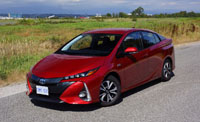
As usual I’ve scanned the many Toyota Canada retail websites and found plenty new 2019 Prius Prime examples to purchase, no matter which province I searched. What this means is a good discount when talking to your local dealer, combined with Toyota’s zero-percent factory leasing and financing rates for 2019 models, compared to a best-possible 2.99-percent for the 2020 version.
As always I searched this information out right here on CarCostCanada, where you can also learn about most brands and models available, including the car on this page, which is found on our 2019 Toyota Prius Prime Canada Prices page. The newer version is found on our 2020 Toyota Prius Prime Canada Prices page, by the way, or you can search out a key competitor such as the Hyundai Ioniq, found on the 2019 Hyundai IONIQ Electric Plus Canada Prices page or 2020 Hyundai IONIQ Electric Plus Canada Prices page (the former offers a zero-percent factory leasing and financing deal, while the latter isn’t quite as good a deal at 3.49 percent). CarCostCanada also provides info about manufacturer rebates and dealer invoice pricing, which arm you before arriving at the dealership so you can get the best possible deal.
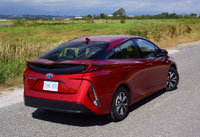
While these pages weren’t created with the latest COVID-19 outbreak in mind, and really nothing was including the dealerships we use to test cars and purchase them, some who are reading this review may have their lease expiring soon, while others merely require a newer, more reliable vehicle (on warranty). At the time of writing, most dealerships were running with full or partial staff, although the focus seems to be more about servicing current clientele than selling cars. After all, it’s highly unlikely we can simply go test drive a new vehicle, let alone sit in one right now, but buyers wanting to take advantage of just-noted deals can purchase online, after which a local dealer would prep the vehicle before handing over the keys (no doubt while wearing gloves).
Back to the car in question, we’re very far into the 2020 calendar year, not to mention the 2020 model year, but this said let’s go over all the upgrades made to the 2020 Prius Prime so that you can decide whether to save a bit on a 2019 model or pay a little extra for the 2020 version. First, a little background info is in order. Toyota redesigned the regular Prius into its current fourth-generation iteration for the 2016 model year, and then added this plug-in hybrid (PHEV) Prime for the 2017 model year. The standard hybrid Prius received many upgrades for 2019, cleaning up styling for more of a mainstream look (that didn’t impact the version being reviewed now, by the way), but the latest 2020 Prius Prime was given a number of major updates that I’ll go over now.
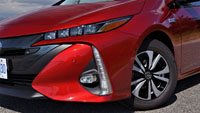
Interestingly (in other words, what were they thinking?), pre-refreshed Prius Prime models came with glossy white interior trim on the steering wheel spokes and shift lever panel, which dramatically contrasted the glossy piano black composite found on most other surfaces. Additionally, Toyota’s Prius Prime design team separated the rear outboard seats with a big fixed centre console, reduced a potential five seats to just four for the 2019 model year. Now, for 2020, the trim is all black shiny plastic and the rear seat separator has been removed, making the Prime much more family friendly. What’s more, the 2020 improves also include standard Apple CarPlay, satellite radio, a sunvisor extender, plus new more easily accessible seat heater buttons, while two new standard USB-A charging ports have been added in back.
Moving into the 2020 model year the Prime’s trim lineup doesn’t change one iota, which means Upgrade trim sits above the base model once again, while the former can be enhanced with a Technology package. The base price for both 2019 and 2020 model years is $32,990 (plus freight and fees) as per the aforementioned CarCostCanada pricing pages, but on the positive Toyota now gives you cargo cover at no charge (it was previously part of the Technology package). This reduces the Technology package price from $3,125 to $3,000, a $125 savings, and also note that this isn’t the only price drop for 2020. The Upgrade trim’s price tag is $455 lower in fact, from $35,445 to $34,990, but Toyota doesn’t explain why. Either way, paying less is a good thing.
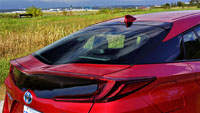
As for the Prius Prime’s Upgrade package, it includes a 4.6-inch bigger 11.6-inch infotainment touchscreen that integrates a navigation system (and it also replaces the Scout GPS Link service along with its 3-year subscription), a wireless phone charger, Softex breathable leatherette upholstery, an 8-way powered driver seat (which replaces the 6-way manual seat from the base car), illuminated entry (with step lights), a smart charging lid, and proximity keyless entry for the front passenger’s door and rear liftgate handle (it’s standard on the driver’s door), but interestingly Upgrade trim removes the Safety Connect system along with its Automatic Collision Notification, Stolen Vehicle Locator, Emergency Assistance button (SOS), and Enhanced Roadside Assistance program (three-year subscription).
My tester’s Technology package includes fog lamps, rain-sensing windshield wipers, a helpful head-up display unit, an always appreciated auto-dimming centre mirror, a Homelink remote garage door opener, impressive 10-speaker JBL audio, useful front parking sensors, semi-self-parking, blind spot monitoring, and rear cross-traffic alert.
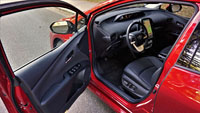
You might think an appropriate joke would be to specify the need for blind spot monitoring (not to mention paying close attention to your mirrors) in a car that only makes 121 net horsepower plus an unspecified amount of torque from its hybrid power unit, plus comes with an electronic continuously variable automatic (CVT) that’s not exactly performance-oriented (to be kind), all of which could cause the majority of upcoming cars to blast past as if it was only standing still, but as with most hybrids the Prime is not as lethargic as its engine specs suggest. The truth is that electric torque comes on immediately, and although AWD is not available with the plug-in Prius Prime, its front wheels hooked up nicely at launch resulting in acceleration that was much more than needed, whether sprinting away from a stoplight, merging onto a highway, or passing big, slower moving trucks and buses.
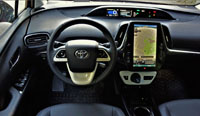
The Prius Prime is also handy through curves, but then again, just like it’s non-plug-in Prius compatriot, it was designed more for comfort than all-out speed, with excellent ride quality despite its fuel-efficient low rolling resistance all-season tires. Additionally, its ultra-tight turning radius made it easy to manoeuvre in small spaces. Of course, this is how the majority of Prius buyers want their cars to behave, because getting the best possible fuel economy is prime goal. Fortunately the 2019 Prius Prime is ultra-efficient, with a claimed rating of 4.3 L/100km city, 4.4 highway and 4.3 combined, compared to 4.4 in the city, 4.6 on the highway and 4.4 combined for the regular Prius, and 4.5 city, 4.9 highway and 4.7 for the AWD variant. This said the Prime is a plug-in hybrid that’s theoretically capable of driving on electric power alone, so if you have the patience and trim to recharge it every 40 km or so (its claimed EV-only range), you could actually pay nothing at all for fuel.
I might even consider buying a plug-in just to get the best parking spots at the mall and other popular stores, being that most retailers put their charging stations closest to their front doors. Even better, when appropriate stickers are attached to the Prime’s rear bumper it’s possible to use the much more convenient (and faster) high-occupancy vehicle (HOV) lane when driving alone during rush hour traffic.
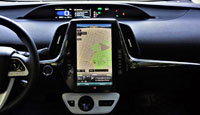
The Prime’s comfort-oriented driving experience combines with an interior that’s actually quite luxurious too. Resting below and in between cloth-wrapped A-pillars, the Prime receives luxuriously padded dash and instrument panel surfacing, including sound-absorbing soft-painted plastic under the windshield and comfortably soft front door uppers, plus padded door inserts front and back, as well as nicely finished door and centre armrests. Toyota also includes stylish metal-look accents and shiny black composite trim on the instrument panel, the latter melding perfectly into the super-sized 11.6-inch vertical touchscreen infotainment display, which as previously mentioned replaces the base Prime’s 7.0-inch touchscreen when moving up to Upgrade trim.
Ahead of delving into the infotainment system’s details, all Prius Primes receive a wide, narrow digital gauge package at dash central, although it is slanted toward the driver with the majority of functions closer to the driver than the front passenger. I found it easy enough to look at without the need to remove my eyes from the road, and appreciated its stylish graphics with bright colours, deep and rich contrasts, plus high resolution. When you upgrade to the previously noted Technology package, you’ll benefit from a head-up display as well, which can positioned for a driver’s height, thus placing important information exactly where it’s needed on the windscreen.
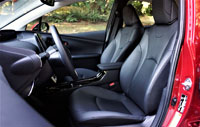
The aforementioned vertical centre touchscreen truly makes a big impression when climbing inside, coming close to Tesla’s ultra-sized tablets. I found it easy enough to use, and appreciated its near full-screen navigation map. The bottom half of the screen transforms into a pop-up interface for making commands, that automatically hides away when not in use.
Always impressive is Toyota’s proprietary Softex leatherette upholstery, which actually breathes like genuine hides (appreciated during hot summer months). Also nice, the driver’s seat was ultra comfortable with excellent lower back support that gets improved upon by two-way power lumbar support, while its side bolsters held my backside in place during hard cornering as well. The Prime’s tilt and telescopic steering column gave me ample reach too, allowing me to get totally comfortable while feeling in control of the car. To be clear, this isn’t always possible with Toyota models.
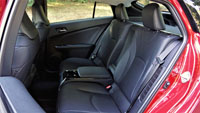
I should mention that the steering wheel rim is not wrapped in leather, but rather more of Toyota’s breathable Softex. It’s impressively soft, while also featuring a heated rim that was so nice during my winter test week. High quality switchgear could be found on its 9 and 3 o’clock spokes, while all other Prius Prime buttons, knobs and controls were well made too. I particularly liked the touch-sensitive quick access buttons surrounding the infotainment display, while the cool blue digital-patterned shift knob, which has always been part of the Prius experience, still looks awesome. All said the new Prius Prime is very high in quality.
Take note that Toyota doesn’t finish the rear door uppers in a plush padded material, but at least everything else in rear passenger compartment is detailed out as nicely as the driver’s and front passenger’s area. Even that previously note rear centre console is a premium-like addition, including stylish piano black lacquered trim around the cupholders and a nicely padded centre armrest atop a storage bin. While many will celebrate its removal for 2020, those who don’t have children or grandkids might appreciate its luxury car appeal. Likewise, I found its individual rear bucket seats really comfortable, making the most of all the Prime’s rear real estate. Yes, there’s a lot of room to stretch out one’s legs, plus adequate headroom for taller rear passengers, while Toyota also adds vent to the sides of each rear seat, aiding cooling in back.
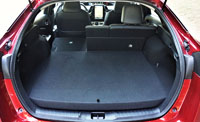
Most should find the Prius Prime’s cargo hold adequately sized, as it’s quite wide, but take note that it’s quite shallow because of the large battery below the load floor. It includes a small stowage area under the rearmost portion of that floor, filled with a portable charging cord, but the 60/40-split rear seats are actually lower than the cargo floor when dropped down, making for an unusually configured cargo compartment. Of course, we expect to make some compromises when choosing a plug-in hybrid, but Hyundai’s Ioniq PHEV doesn’t suffer from this issue, with a cargo floor that rests slightly lower than its folded seatbacks.
If you think I was just complaining, let me get a bit ornery about the Prius’ backup beeping signal. To be clear, a beeping signal would be a good idea if audible from outside the car, being that it has the ability to reverse in EV mode and can therefore be very quiet when doing so, but the Prius’ beeping sound is only audible from inside, making it totally useless. In fact, it’s actually a hindrance because the sound interferes with the parking sensor system’s beeping noise, which goes off simultaneously. I hope Toyota eventually rights this wrong, because it’s the silliest automotive feature I’ve ever experienced.
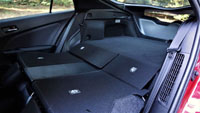
This said the Prius’ ridiculous reverse beeper doesn’t seem to slow down its sales, this model having long been the globe’s best-selling hybrid-electric car. It truly is an excellent vehicle that totally deserves to don the well-respected blue and silver badge, whether choosing this PHEV Prime model or its standard trim.
Story and photo credits: Trevor Hofmann
